|
|
Annotated Table of Contents: Rhythm and Transforms |
How can rhythm be described mathematically? How can rhythm be detected automatically? People spontaneously clap in time with a piece of music -- but it is tricky to create a computer program that can ``tap its foot'' to the beat. Some peculiar features of the mind help us to internalize rhythms. Teaching the computer to synchronize to the music may require some peculiar mathematics and some idiosyncratic kinds of signal processing. The first chapter of Rhythm and Transforms is segmented into nice web-sized chunks for your browsing pleasure:
| Introduction | ||
| Rhythm, Periodicity, Regularity, Recurrence |
|
|
| Perception and Time Scale | ||
| Illusions of Sound Perception | ||
| Beat Tracking | ||
| Why Study Rhythm? | ||
| Overview of Rhythm and Transforms | ||
| Sound Examples: Teasers |
There are many different ways to think about and notate rhythmic patterns. Visualizing and Conceptualizing Rhythm introduces the notations, tablatures, conventions, and illustrations that will be used throughout Rhythms and Transforms. The distinction between symbolic and literal notations is emphasized.
| 2.1 Symbolic Notations 2.1.1 Lyrical Notation 2.1.2 Musical Notation 2.1.3 Necklace Notation 2.1.4 Numerical Notations 2.1.5 Functional Notation 2.1.6 Drum/Percussion Tablature 2.1.7 Schillinger's Notation 2.1.8 MIDI Notation 2.1.9 Harmonic Rhythm 2.1.10 Dance Notation 2.1.11 Juggling Notation 2.2 Literal Notations 2.2.1 Waveforms 2.2.2 Spectrograms 2.2.3 Granular Representations 2.3 Visual and Physical Metaphors for Rhythm |
 |
Surveying the musics of the world shows many different ways of conceptualizing the use of rhythmic sound.
| 3.1 Fluid, Unmeasured, and Beatless 3.2 Meter 3.3 Additive vs. Divisive 3.4 Timelines 3.5 The Clave 3.6 Samba 3.7 Vodou Drumming 3.8 Tala 3.9 Polyrhythms 3.10 Inner Melody and the Gamelan 3.11 Funk 3.12 Hip Hop 3.13 Simultaneous Tempos 3.14 Synthesis |
 |
The auditory system is not simple. Underlying the awareness of rhythmic sounds are basic perceptual laws that govern the recognition of auditory boundaries, events, and successions. Research into the mechanisms of perception sheds light on the physical cues that inspire rhythmic patterns in the mind of the listener. These cues help distinguish features of the sound that are properties of the signal from those that are properties of the perceiving mind. The beat is not in the signal; it is in your mind.
| 4.1 How the Ear Works 4.1.1 Perception of Loudness 4.1.2 Critical Band and JND 4.1.3 Models of the Auditory System 4.2 Auditory Boundaries 4.3 Regular Successions 4.3.1 Perceptions of Rate 4.3.2 Regular Successions as a Single Perception 4.3.3 Perceptual Cues for Clustering of Notes 4.3.4 Perceptual Cues for Clustering of Rhythms 4.3.5 Filled vs. Empty Durations 4.3.6 Framework for Rhythm Perception 4.3.7 A Rhythmic Theory of Perception 4.3.8 Rhythm Without Notes 4.3.9 Changes to Regular Successions 4.3.10 Multiple Regular Successions 4.3.11 One-Hundred Metronomes 4.4 Feature vectors: Perceptually Motivated Preprocessing 4.4.1 Critical Band Feature Vectors 4.4.2 Listening to Feature Vectors I 4.4.3 Extracting Auditory Boundaries from a Signal 4.4.4 Listening to Feature Vectors II 4.5 Perception vs. Reality |
 |
Transforms model a signal as a collection of waveforms of a particular form: sinusoids for the Fourier transform, mother wavelets for the wavelet transforms, periodic basis functions for the periodicity transforms. All of these methods are united in their use of inner products as a basic measure of the similarity and dissimilarity between signals, and all may be applied (with suitable care) to problems of rhythmic identification. Here is a (slightly early) electronic version of Chapter 5.
| 5.1 Inner Product: The Angle Between Two Signals 5.2 Correlation and Autocorrelation 5.3 The Fourier Transform 5.3.1 Frequency via the DFT/FFT 5.3.2 Three Mistakes 5.3.3 Short-time Fourier Transform 5.3.4 The Phase Vocoder 5.4 Wavelet Transforms 5.5 Periodicity Transforms 5.5.1 Periodic Subspaces 5.5.2 Projection onto Periodic Subspaces 5.5.3 Algorithms for Periodic Decomposition 5.5.4 Signal Separation 5.5.5 Choice of Sampling Rate 5.5.6 Discussion of PT 5.6 Summary |
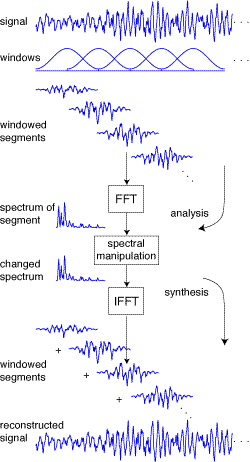 |
One way to model biological clocks is with oscillators that can adapt their period and phase to synchronize to external events. To be useful in the beat tracking problem, the oscillators must be able to synchronize to a large variety of possible input signals and they must be resilient to noises and disturbances.Clock models can be used to help understand how people process temporal information and the models are consistent with the importance of regular successions in cognition and perception.
| 6.1 Entrainment and Synchronization 6.2 Systems Notation 6.3 Oscillators 6.4 Adaptive Oscillators 6.4.1 The Phase Locked Loop 6.4.2 Adaptive Wavetable Oscillators 6.4.3 Adaptive Phase-Reset Oscillators 6.4.4 Adaptive Clocking 6.5 Behavior of Adaptive Oscillators |
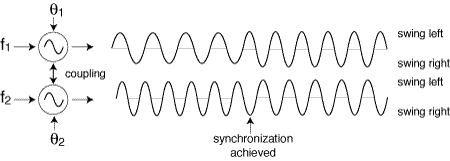 |
The search for rhythmic patterns can take many forms. Models of statistical periodicity do not presume that the signal itself is periodic; rather, they assume that there is a periodicity in the underlying statistical distributions. In some cases, the randomness is locked to a known periodic grid on which the statistics are defined. In other cases, the random fluctuations may be synchronized to a grid with unknown period. In still other cases, the underlying rate or period of the repetition may itself change over time. The statistical methods relate the signal (for example, a musical performance) to the probability distribution of useful parameters such as the period and phase of a repetitive phenomenon. These form the backbone of the beat tracking system that will be used throghout the remainder of Rhythm and Transforms.
| 7.1 Probability and Inference 7.2 Statistical Models of Periodic Phenomenon 7.3 Regularities in Binary Sequences 7.4 A Model for Symbolic Pulse Detection 7.5 A Model for Symbolic Pulse Tracking 7.6 A Model for Audio Feature Vectors |
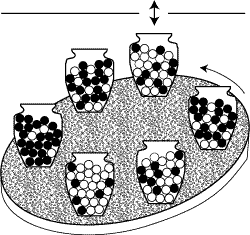 |
Just as there are two kinds of notations for rhythmic phenomenon (the symbolic and the literal), there are two ways to approach the detection of rhythms; from a high level symbolic representation (such as an event list, musical score, or standard MIDI file) or from a literal representation such as a direct encoding in a .wav file. Both aspire to understand and decompose rhythmic phenomena, and both exploit a variety of technologies such as the transforms, adaptive oscillators, and statistical techniques of Chapters 5 - 7. This chapter begins with a discussion of the rhythmic parsing of symbolic sequences and then incorporates the perceptually motivated feature vectors of Chapter 4 to create viable beat detection algorithms for audio. The performance of the various methods is compared in a variety of musical passages.
| 8.1 Analysis From a Musical Score: La Marseillaise 8.1.1 Rule-Based Approaches 8.1.2 Transform Techniques 8.1.3 Statistical Methods 8.1.4 Adaptive Oscillators 8.2 MIDI Beat Tracking 8.2.1 Adaptive Oscillators 8.2.2 Statistical Methods 8.3 Audio Beat Tracking 8.3.1 Transform Techniques 8.3.2 Statistical Beat Tracking 8.3.3 Beat Tracking Using Adaptive Oscillators 8.4 Summary |
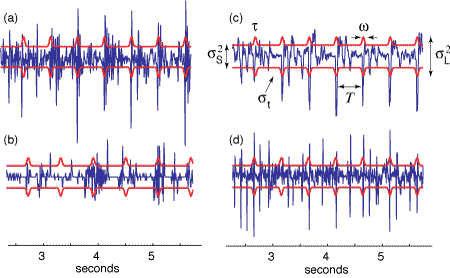 |
There is an old adage in signal processing: if there is information, use it. The ability to detect beat timepoints is information about the naturally occurring points of division within a musical signal and it makes sense to exploit these points when manipulating the sound. Signal processing techniques can be applied on a beat-by-beat basis or the beat can be used to control the parameters of a continuous process. Applications include beat-synchronized special effects, spectral mappings with harmonic and/or inharmonic destinations, and a variety of sound manipulations that exploit the beat structure. A series of sound examples demonstrate.
| 9.1 Manipulating the Beat 9.2 Beat-Synchronous Filters 9.3 Beat-Based Time Reversal I 9.4 Beat-Based Averaging 9.5 Separating Signal from Noise 9.6 Spectral Mappings 9.6.1 Mapping to a Harmonic Template 9.6.2 Mapping to a n-tet Template 9.6.3 The Make Believe Rag 9.7 Nonlinear Beat-Based Processing 9.7.1 Spectral Band Filter 9.7.2 Spectral Freeze 9.7.3 The Harmonic Sieve 9.7.4 Instantaneous Harmonic Templates 9.8 The Phase Vocoder vs. the Beat-Synchronous FFT 9.8.1 Implementations 9.8.2 Perceptual Comparison |
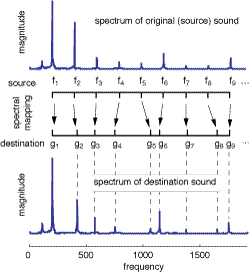 |
The beats of a single piece may be rearranged and reorganized to create new structures and rhythmic patterns including the creation of beat-based "variations on a theme." Musical uses are discussed, and new forms of rhythmic transformation and modulation are introduced. Two pieces may be merged in a time-synchronous manner to create hybrid rhythmic textures that inherit tonal qualities from both. A series of sound examples demonstrate.
| 10.1 Friend of the Devil of the Friend 10.2 "New" Pieces from Old 10.3 The Maple Leaf Waltz, Julie's March, and Take Four 10.4 Beat-Based Time Reversal II 10.5 Beat Randomization 10.6 Beat-Synchronous Sound Collages 10.7 Beat-Synchronous Cross-Performance |
 |
Traditional musical analysis often focuses on the use of note-based musical scores. Since scores only exist for a small subset of the world's music, it is helpful to be able to analyze performances directly, to probe both the literal and the symbolic levels. This chapter uses the beat tracking of Chapter 8 to provide a skeletal tempo score that captures some of the salient aspects of the rhythm. By conducting analyses in a beat-synchronous manner, it is possible to track changes in a number of psychoacoustically significant musical variables. This allows the automatic extraction of new kinds of symbolic feature scores directly from the performances.
| 11.1 Accuracy of Performance 11.2 Beat Regularization 11.3 Beat-Synchronous Feature Scores 11.4 Julie's Waltz: An Analysis |
 |
Rhythm and Transforms begins with a review of basic psychoacoustic principles and a brief survey of musical rhythms throughout the world. The three different pattern finding techniques of Chapters 5 - 6 - 7 lead to a series of algorithms that show promise in solving the automated beat tracking problem. Chapters 9 - 10 -11 explore the uses of a beat-based viewpoint in audio signal processing, composition, and musical analysis. Most of the book stays fairly close to "the facts," without undue speculation. This final chapter ventures further.
| 12.1 Which Comes First, the Notes or the Beat? 12.2 Name That Tune 12.3 Variations on a Theme 12.4 What is a Song? 12.5 Time and Perceived Time 12.6 The Technologies for Finding Patterns |
 |